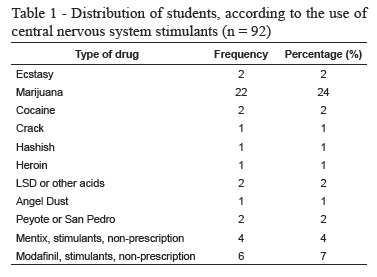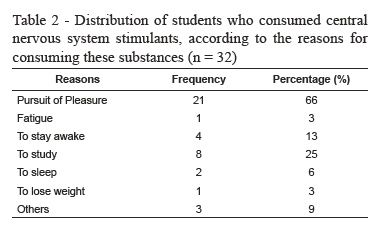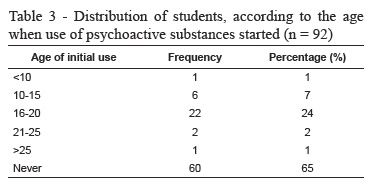SMAD. Revista eletrônica saúde mental álcool e drogas
ISSN 1806-6976
SMAD, Rev. Eletrônica Saúde Mental Álcool Drog. (Ed. port.) vol.9 no.2 Ribeirão Preto ago. 2013
ORIGINAL ARTICLE
Consumption of Central Nervous System Stimulants among Medical and Nursing Students at a Chilean University
Reflexo do consumo de estimulantes no sistema nervoso central nos estudantes de enfermagem e medicina de uma universidade chilena
Carmen Gloria-GarcésI; Kelly Graziani Giacchero VedanaII
IPhD, Adjunct Professor, Universidad Valparaíso, Valparaíso, Chile
IIPhD, Professor, Escola de Enfermagem de Ribeirão Preto, Universidade de São Paulo, WHO Collaborating Centre for Nursing Research Development, Ribeirão Preto, SP, Brazil
ABSTRACT
The study aimed to determine the prevalence of psychostimulant consumption among medical and nursing students at a Chilean university, the personal characteristics and motivations for the use of these substances. This is a descriptive, transversal research with a quantitative approach. The sample was comprised of 92 students. Data collection occurred in 2011 through structured research. Descriptive statistics were used for the data analysis. The students were young, and 35% of them had previously consumed psycho stimulants. The main motivator was the pursuit of pleasure; need to stay awake, and to study. The difference in consumption between the genders was negligible. Research in this area is important to characterize the substance users, to monitor consumption patterns and develop strategies.
Descriptors: Central Nervous System Stimulants; Students, Medical; Students, Nursing.
RESUMO
O objetivo deste estudo foi determinar a prevalência de consumo de psicoestimulantes, em estudantes de enfermagem e medicina, numa universidade chilena, e as características pessoais e motivações para o consumo dessas substâncias. Esta pesquisa é descritiva, transversal e com abordagem quantitativa. Participaram 92 estudantes. A obtenção dos dados ocorreu em 2011, mediante pesquisa estruturada. Foi utilizada estatística descritiva para análise dos dados. Os estudantes eram jovens e 35% já tinham consumido psicoestimulantes. As principais motivações para o consumo foram prazer, a necessidade de não dormir e estudar. Foi observada pouca diferença no consumo entre essas motivações. Pesquisas dessa natureza são importantes para caracterizar as pessoas que usam substâncias, monitorar os padrões de consumo e poder projetar estratégias.
Descritores: Estimulantes del Sistema Nervioso Central; Estudiantes de Medicina; Estudiantes de Enfermería.
Introduction
Psychoactive substances or drugs are chemical substances, which affect brain functions resulting in alterations in consciousness, perceptions and physical or psychological performance, which in some cases may result in dependency(1).
A psychoactive substance can act upon the central nervous system in different ways: as either a depressant or a stimulant.
The central nervous system stimulation can result in alertness, increased physical performance, and acceleration of psychic processes, fatigue reduction, and decreased appetite. This class includes cocaine, crack cocaine, amphetamines, methamphetamines, nicotine, and caffeine.
Over the past 15 years, the world has observed an increase in the consumption and availability of amphetamines; within a 200 million population of drug users worldwide, 35 million uses amphetamine stimulants (ETA).
The use of central nervous system stimulants (CNSS) has seen an increase among young students; exponentially heightening the potential of abuse.
It is estimated that 25% of the Honduran college population use some kind of drugs. Several American studies demonstrated a prevalence of stimulant use among college students, ranging from 0-15%(2).
The use of alcohol and other drugs is a problem affecting especially the adolescents and young adults. A Colombian university study demonstrated that the use of psychoactive substances was higher among the students than in the general population(3).
In Chile, in 2010, the use of freebase cocaine and tobacco was also higher among college students.
There are many reasons for the drug use among college students. Among them the need to reduce stress related to high academic and social demands(4), curiosity, the pursuit of pleasure; the need for more study time and to make friends(5), to increase the concentration and energy levels to improve the academic performance, recreation(2) and to suppress the appetite. Furthermore, students in the health field may have greater access to psychiatric drugs(4).
Patterns of alcohol and drug use are associated with the occurrence of other physical and psychological problems affecting not only the individuals, but their families and friends and the community as a whole(2).
Here are some of the effects resulting from the use of central nervous system stimulants (CNSS): Organ damage; cognitive and memory deterioration; decision making and self-control impairment; feelings of paranoia, depression and panic attacks(3); greater exposure to risky situations; higher economic expenditures, in addition to the human and social costs.
Drug abuse is present in every social stratum, relating to various problems. Efforts are needed to control substance abuse to curtail their international repercussions(6).
There is a scarcity, in the literature, of Chilean studies dealing with substance use among medical school students(4). However, for a successful prevention it is important to gather the appropriate information related to the age at the onset of consumption, risk factors, gender differences, and to determine the types of resources and how to use them.
Knowledge of the characteristics of the drug users among the Chilean college students can be helpful when drafting policies and strategies focused on the prevention of substance use.
The public health system and the universities have the responsibility for conducting research and to intervene in the consumption of stimulants among college students(5); it is of great importance for the universities to perform their own analyses to find out the extent of the problem.
For all that has been stated above, it is understood that a diagnosis from the educational institutions is very relevant for the implementation of effective preventive measures.
Objectives
The aim of the study was to determine the prevalence of the central nervous system stimulants use among students attending the first and fourth year of nursing and fourth year of medical schools at a Chilean university; the personal characteristics and motivations in relation to consumption of psychoactive substances, as related by the students.
Methodology
This is a descriptive, transversal study with a quantitative approach.
The study was conducted at a Chilean university. The sample comprised 92 university students attending the first and fourth years of nursing and fourth year of medical schools in 2011. It included students of both genders with ages 18 and over.
The university offers courses for the following careers: nursery, nursing, speech therapy, medicine, medical technology, obstetrics, and childcare. This campus is located near the capital of Chile in an area surrounded by many villages, predominantly rural with the prevalence of vineyards and copper mining activities.
The duration of the nursing bachelor´s degree course is about 5 years (10 semesters), with full-time attendance, and medical school has a duration of 7 years, with a full-time load, as well.
Data were obtained after permission from the site of the study; all participants signed the Term of Free and Cleared Consent. The research followed the Declaration of Helsinki principles.
Data collection occurred in 2011 through a structured survey with self applied closed-ended question questionnaire, after the signing of the informed consent. A pilot study to verify understanding of the research was conducted prior to the data collection.
Data were tabulated in an Excel 2007 form, and its analysis was performed with the STATA 11 statistical software using descriptive statistics.
Results
A total of 110 individuals meeting the inclusion criteria were invited to participate in the study. Of which 92 students, with ages varying from 18 to 27, agreed to participate in the study. Of the students, 42% lived with their original families. Most were nursing students (73%), females (65%), and singles (93%), did not work (77%) and only occasionally or never participate in sports (73%).
With regard to study habits, 48 (52%) reported having bad study habits and 69 (75%) preferred to study at night. Most respondents (80%) mentioned insufficient time to study during the day.
It was observed that 32 (35%) subjects were under the influence of central nervous system stimulants during the data collection. Significant differences in stimulant use were identified between the nursing and medical students. Among nursing students, 40% consumed central nervous system stimulants while only 20% of the medical students did.
Students living away from home consumed more stimulants than those who still lived with their families, with a significant difference in numbers.
There were more male users than female, but the difference was not significant. Single people consumed more than the couples, again the difference was negligible.
The first table shows the student distribution according to the substances used.
Marijuana use was higher compared to the other psychoactive substances used by students; followed by the use of non-prescription drugs.
The next table shows the motivations, reported by the students, for the consumption of psychoactive substances.
Pursuit of pleasure, need to stay awake, and to study were the predominant reasons for the use of central nervous system stimulants. Table 3 


Among the students who participated in the study, 60 (65%) reported never having experimented with psychoactive substances. Among the respondents who had consumed substances, most started experimenting before the age of 21.
Discussion
The sample was composed of mostly young, student nurses, and females, unmarried, unemployed and who only occasionally participated in sports or never did. Among the respondents, 35% had used central nervous system stimulants.
Marijuana use was higher (24%) compared to the other psychoactive substances used by the students. Among the general population of Chile, in 2010, the marijuana use was greater than the other psychoactive substances, being second only to tobacco and alcohol(6-7). A study conducted with college students in Ecuador also found that the most commonly used substances were alcohol, tobacco and marijuana(8).
The second most widely consumed stimulant by students were the non-prescription psycho stimulant drugs (11%), which may be related to the ease access to these substances among undergraduate students in the health field. This problem is not limited to stimulants or Chile for that matter. Research conducted among nursing students from Ecuador showed that 10.5% of them had consumed non-prescription benzodiazepines at least once(9).
A Comparison of the results of this study with the prevalence of lifetime use of drugs among the general population of Chile in 2010 shows that the students surveyed consumed more marijuana, ecstasy and crack cocaine, and consumed less cocaine than the general population(7).
This study also found no significant difference between stimulant use among males and females in our sample. It was identified that nursing students consumed more drugs than medical students and that students living away from home used more stimulants than those who still lived with their families.
Among the respondents who had consumed drugs, most started experimenting before the age of 21. A Study with college students in El Salvador found that the first experimentation with drugs started between the ages of 13 and 21; and that at age 21, 94.7% had experimented with drugs at least once. Alcohol was the first drug used, followed by inhalants, marijuana, benzodiazepines, and amphetamines(10). The use of these substances starts at an early age; thus, demonstrating the need for preventive strategies directed toward this population.
Regarding the study habits of the participants of this survey, most reported having bad study habits, preferably studying at night and considered insufficient the time available for study. It would be valuable to conduct study habits workshops for students to help them manage their time.
The pursuit of pleasure was the main reason for the use of central nervous system stimulants, followed by the need to stay awake, and to study. Other studies also highlight that for college students, the pursuit of pleasure as one of the main reasons to use psychoactive substances(11-13).
The stress related to academic life, the transitioning, school adjustment, stress related to the practical activities, changes in lifestyle and the lack of protection mechanisms, containment and prevention of drug use by the educational system may have implications on the quality of the mental health and the education of the future health care workers.
It can be inferred that students in the health field are knowledgeable about the effects of drugs(11). But there may be a tendency, among students, that they have a control over the negative impact of the drugs on themselves and that it is harmful only to people who do not have a control over it(10).
The future health workers must be prepared to treat patients with problems related to substance use and their attitudes toward the consumption may influence their professional behavior(11).
Researchers recommend that undergraduate courses in the area of health introduce the promotion of self responsibility in caring for their own health and stress the importance of social responsibility required from the future health workers(12).
The consumption of psychoactive substances can increase the involvement in risk situations such as unprotected sexual activity, traffic accidents, and violence(8, 14).
Final Considerations
This study surveyed students at a Chilean university and found that 35% of the subjects had used central nervous system stimulants. Marijuana was the drug of choice, followed by non-prescription psychostimulant drugs. The main motivator was the pursuit of pleasure; need to stay awake and to study.
Nursing students consumed more drugs than medical students, and students living away from home used more stimulants than those who still lived with their families. The difference in consumption between the genders was negligible.
Researches of this nature are important to characterize the substance users, to monitor consumption patterns and develop strategies.
The results indicate the need for further studies related to the topic, epidemiological surveillance and educational works and health promotion which, in the long run, remain directed to risk groups.
References
1. Navia-Bueno MP, Farah-Bravo J, Yaksic-Feraudy N, Philco-Lima P, Takayanagui AMM. Knowledge on drugs phenomenon by students and faculty from the Medical School at Universidad Mayor de San Andrés, La Paz, Bolivia. Rev. Latino-Am. Enfermagem. 2011;19(n.espec):722-9. [ Links ]
2. Buchanan JC, Pillon SC. Drug consumption by medical students in tegucigalpa, Honduras. Rev. Latino-Am. Enfermagem. 2008;16(n. espec):595-600. [ Links ]
3. Mosquera JC, Artamonova I, Mosquera VS. Consumo de substancias psicoactivas en la Universidad tecnológica de Pereira, Colombia. Investigaciones Andinas. 2011;13(22):194-210. [ Links ]
4. Romero MI, Santander J, Hitschfeld MJ, Labbé M, Zamora V. Consumo de sustancias ilícitas y psicotrópicos entre los estudiantes de Medicina de la Pontificia Universidad Católica de Chile. Rev Med Chile. 2009;137(4):59-65. [ Links ]
5. Urrego MA, Orozco LA, Montoya LB, Soto LB, Velazquez DVC, Castrillon JJC, et al. Consumo de anfetaminas, para mejorar el rendimiento académico, en estudiantes de la Universidad de Manizales. Arch Med. 2008;9(1):43-57. [ Links ]
6. Costa MCS, Ortiz Rebolledo N, Lopes LM. Uso de drogas no chile: pesquisa documental e bibliográfica. SMAD, Rev. Eletrônica Saúde Mental Álcool Drog. (Ed. port.). [Internet]. 2007. [acesso 18 jun 2009];3(1). Disponível em: http://pepsic.bvsalud.org/scielo.php?script=sci_issues&pid=1806-6976&lng=pt&nrm=iso [ Links ]
7. Consejo Nacional para el Control de Estupefacientes (CONACE)(CH). Resumen Ejecutivo Noveno Estudio Nacional de Drogas en Población General, 2010. Santiago de Chile; 2011. [ Links ]
8. Pillon SC, O'Brien B, Chavez KAP. The relationship between drugs use and risk behaviors in brazilian university students. Rev. Latino-Am. Enfermagem. 2005;13(n. spe2):1169-76. [ Links ]
9. Paredes NP, Miasso AI, Tirapelli CR. Consumption of benzodiazepines without prescription among first-year nursing students at the University of Guayaquil, school of nursing, Ecuador. Rev. Latino-Am. Enfermagem. 2008;16(n spe):634-9. [ Links ]
10. Ortega-Perez CA, Costa-Junior ML, Vasters GP. Epidemiological profile of drug addiction in college students. Rev. Latino-Am. Enfermagem. 2011;19(n.espec):665-72. [ Links ]
11. Lemos KM, Neves NMBC, Kuwano AY, Tedesqui G, Bitencourt AGV, FBCS, et al. Psychoactive substance use by medical students from Salvador (BA). Rev Psiq Clín. 2007;34(3):118-24. [ Links ]
12. Henriquéz PC, Carvalho AMP. Perceptions of drugs benefits and barriers to quit by undergraduate health students. Rev. Latino-Am. Enfermagem. 2008;16(n spe):621-6. [ Links ]
13. Matute RC, Pillon SC. Alcohol consumption by nursing students in Honduras. Rev. Latino-Am. Enfermagem. 2008;16(espec):584-9. [ Links ]
14. Wagner GA, Andrade AG. The use of alcohol, tobacco and other drugs among Brazilian college students. Rev Psiq Clín. 2008;35(supl 1):48-54. [ Links ]
 Correspondence
Correspondence
Kelly Graziani Giacchero Vedana
Universidade de São Paulo. Escola de Enfermagem de Ribeirão Preto
Departamento de Enfermagem Psiquiátrica e Ciências Humanas
Av. Bandeirantes, 3900
Bairro: Monte Alegre
CEP: 14040-902, Ribeirão Preto, SP, Brasil
E-mail: kellygiacchero@eerp.usp.br
Received: Aug. 10th 2012
Accepted: Feb. 21st 2013













